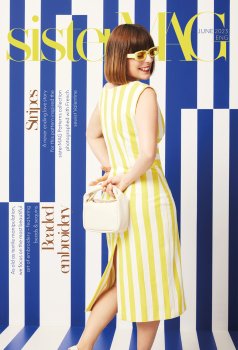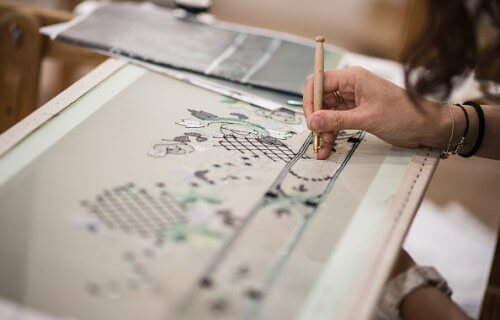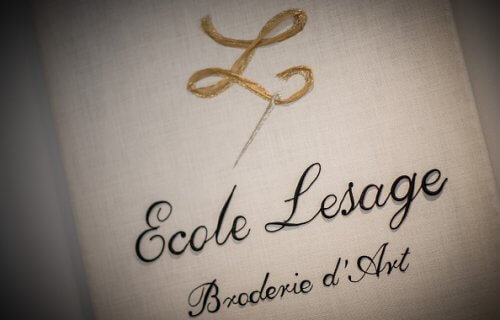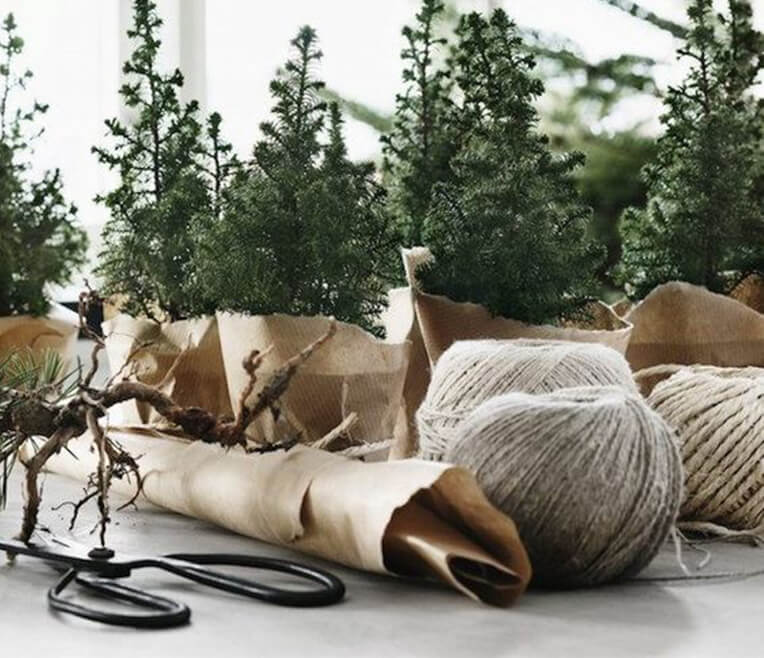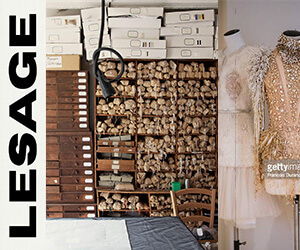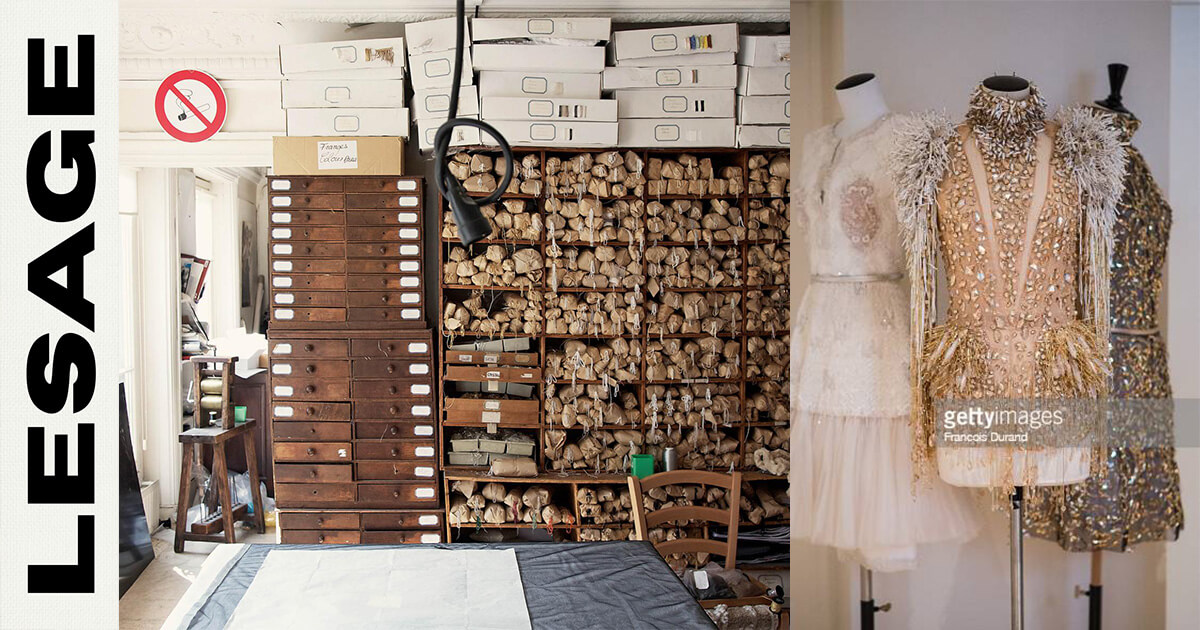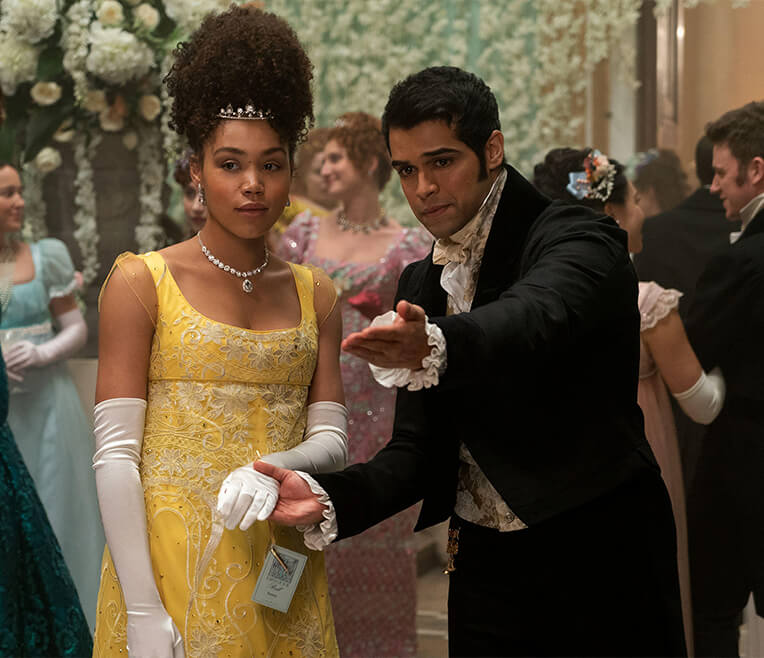
Maison Lesage – Embroidery Art from Paris
Perhaps you’ve already seen it: the fantastic embroidery on equally fine materials. This embroidery is inspired by art and captivates our senses with imaginative, colorful, and harmonious designs adorned on fabric. These intricately beautiful creations are usually attributed to the Parisian embroidery workshop Maison Lesage. We introduce you to this special manufactory.
- Text: Michael Neubauer
Maison Lesage – Embroidery Art from Paris
Hardly any major fashion label in the world seeking to embellish their designs with embroidery can pass up on the skill of this fashion house. An impressive company history rooted deeply in tradition culminate in an archive of embroidery templates behind the walls at Place Skanderberg in Paris that is at the service of many couturiers and luxury fashion houses. With 80,000 templates for haute couture, ready-to-wear items, and other accessories, they are a source of inspiration for everyone. The archive is alive and continually being expanded, as mentioned by artistic director Hubert Barrère in an interview with Runway magazine in 2019.
The mid 19th century: where it began
In the mid 19th century, Charles Frederick Worth (1825-1895) appeared on the Paris fashion scene, a designer who would go on to define French fashion for decades to come. He made popular fashion more suitable for everyday wear, defined the French empress, Eugénie’s sense of style, and was the first to replace mannequins with real life models. Always looking for new ideas, the busy couturier, employing up to 1,200 people, found the partner he was looking for in the embroidery workshop Michonet, founded in 1858. La Maison Michonet made a name for itself with its embroidery art for theatre costume designers and custom pieces for the house of Napoleon III. Famous fashion designers from the late 19th century such as Madeleine Vionnet and Jean Paquin were also using Michonet.
The beginning
In 1924, Albert and Marie-Louise Lesage acquired Albert Michonet’s embroidery workshop. Albert Lesage (1888-1949) ended up in Chicago as a prisoner of war and had worked there as a designer for Marshall Field’s from 1919. In 1922, he had returned to Paris and started at La Maison Michonet, who were now looking for a successor for the company founder, Albert Michonet. Now married to Marie-Louise Favot, who’d worked at the Vionnet fashion house, Albert Lesage et Cie began a close working relationship with this label. Madeleine Vionnet was famous for her bias-cut dresses that flowed freely about the body. In order not to warp the light fabrics, (Crêpe Romain, Crêpe de Chine, silk chiffon or Charmeuse), Albert Lesage had to adapt his technique. A tambour hook picked up the thread on the back of the fabric and pulled it through to the front for attaching beads and sequins. This technique is still known today as Tambour or Luneville embroidery. Lesage’s creativity and inspiring designs spread quickly throughout the fashion world. Other luxury brands soon followed in addition to the customer base they’d acquired from Michonet. Albert and Marie-Louise won over well-known fashion houses with their extraordinary embroidery patterns, which were the results of countless hours of precise beadwork.
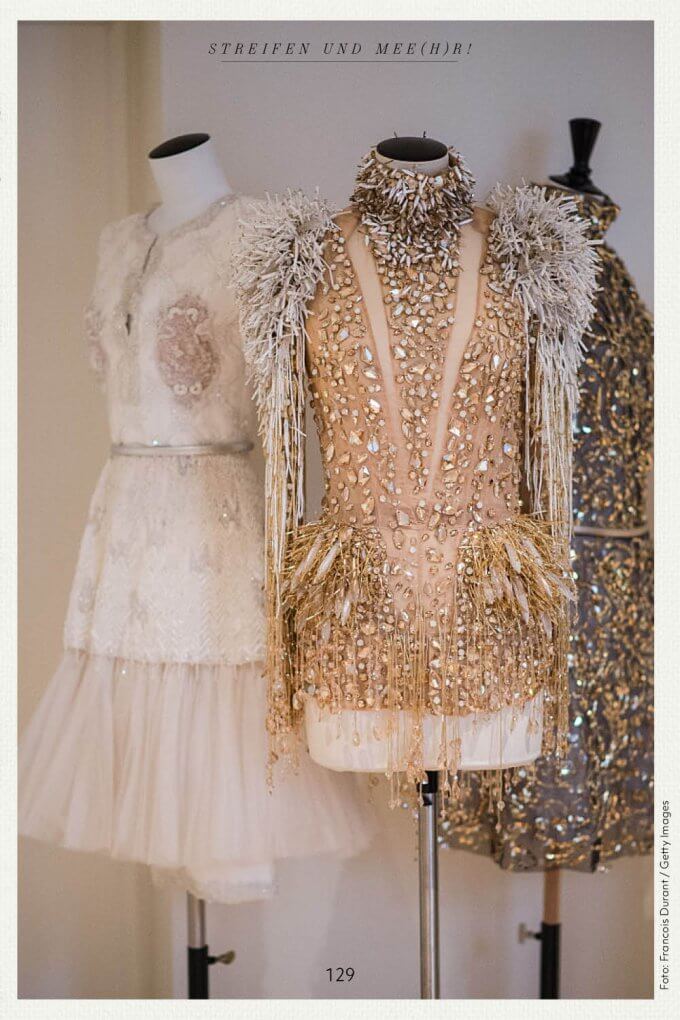
Happiness in misfortune
In a difficult economic situation at the beginning of the 1930s, the Italian fashion designer Elsa Schiaparelli (1890-1973) relieved Albert Lesage of his woes. This was fitting because Maison Lesage et Cie had been gearing its catalog towards more modern styles such as Art Nouveau and Art Deco. Schiaparelli was already highly successful in her industry as an avant-garde surrealist fashion icon. Lesage delivered embroidered belts with gold thread trim and smoothly finished coral and precious stones. Necklaces and collars followed along with collaboratively designed garments. The materials became more and more extravagant. Murano glass to imitate flowers, elements made from lapis lazuli, artificial stones, pebbles, glass beads, gold and silver mirrored glass, chenille was combined with mink, and you could even find fish scales on some pieces. There’s a famous cloak with a sunbeam pattern embroidered with golden sequins. For more than 20 years, they both had a complementary and fruitful collaboration with incredible success. It was a tribute to the symbiotic relationship between design and craftwork.
François, the son
François Lesage (1929-2011) was born to Albert and Marie-Louise Lesage “into a pile of beads and sequins”, with the potential for artistic, creative talent instilled in him from birth. After being trained by his parents, he began his career in the United States, where he embroidered for major Hollywood productions. After his father’s death in 1949, he returned to Paris to take over the family business. François successfully expanded the company to serve countless fashion houses that trusted him as a committed partner who could fulfil their every wish. He maintained relationships with Christian Dior, Cristobel Balenciaga, Christian Lacroix, Hubert de Givenchy, Yves Saint Laurent, John Galliano and Karl Lagerfeld, the creative director of Chanel.
François and Yves Saint Laurent
The collaboration with Yves Saint Laurent was particularly strong intense for over 44 years. In 1988, they both created a jacket and skirt evening collection entitled “Sunflowers” inspired by Van Gogh’s “Vase with 15 Sunflowers”. It was the “pinnacle of Saint Laurent and Lesage’s vision and craftsmanship. It was created from over 350,000 sequins, 100,000 ceramic bugle beads, and individually painted fabric petals… it took more than 770 hours of embroidery.” The following year, Saint Laurent surprised everyone with a jacket decided to his house: “Hommage a ma maison.” This was also hand-embroidered by François Lesage after Yves Saint Laurent’s request for him to do so:
„François, make me something that is like a chandelier reflected in a mirror, with the skies of Paris in the background.“
His wish was granted, and two jackets were made.
François and Karl Lagerfeld
The collaboration with Karl Lagerfeld started in 1983. Lesage was inspired by Boulle furniture and Coco Chanel’s Coromandel screens for Lagerfeld. When a crisis loomed over haute couture in the 1990s and artisan businesses like Lesage were floundering, it was Karl Lagerfeld who persuaded Chanel to acquire Maison Lesage for one of their subsidiaries named Paraffection in 2002.
Maison Lesage and Chanel
Other artisans also started to join. For example, feather work is a specialty of Lemarié, which was also based at Lesage and subsequently bought up by Chanel – just like Maison Michel or shoe manufacturer, Massaro. This ensured that hand crafted fashion could continue to exist in Paris. Every year, in December, Chanel organizes a fashion show named CHANEL Métiers d’Art Show for crafts such as hatters, jewelers, embroiderers, lace makers, feather artists and shoemakers.
François’ Ecole Lesage
In 1992, François opened Ecole Lesage, an embroidery school that still exists today. Training to become an embroiderer is available for skill levels beginner to advanced. Eight basic courses each comprise around 30 hours of instruction. The students receive a detailed overview, beginning with the company history and the particulars of the fashion world since the 1920s. Specialist courses are also available (go to sign-up).
To sum up
Maison Lesage is a family business that was shaped by Albert and his son, François. Competent, creative, agile in their decisions and the highest level of hand crafting, they created the house of Lesage, whose tradition dates back to the mid-19th century, where the origins of fashion and haute couture lie. Over the many years the company has created products that will stand the test of time in terms of their value and the skill they took to create. François Lesage died aged 82 in 2011. Chanel named Hubert Barrère as artistic director of Maison Lesage. Almost nothing has changed in embroidery techniques, it is still hand-made in a factory. Empathy, passion, creativity, and skilled craft still characterize the people who work at Maison Lesage. Computer-aided design tools such as 3D printing and laser technology techniques are now used, as well. “Hand embroidery is something emotional,” says Hubert Barrère. “It isn’t a kind of technical exhibitionism, and its value doesn’t come simply from the hours and hours of meticulous work involved. Above all else, it’s something that comes from the soul, it makes you feel something, without quite knowing why.”

